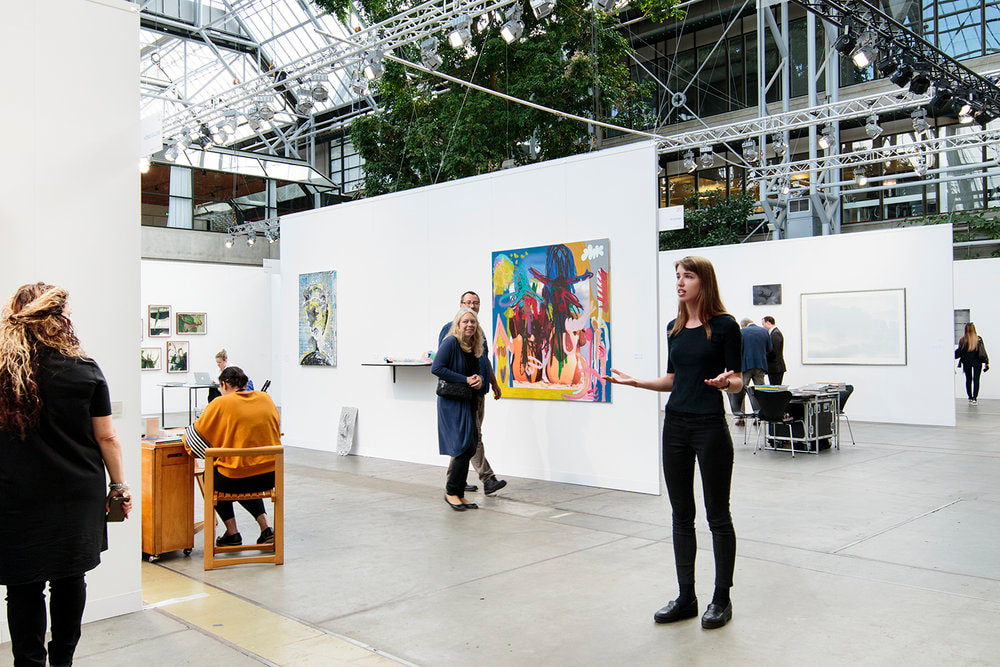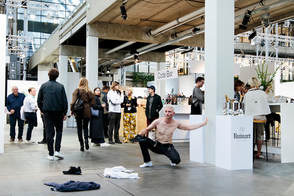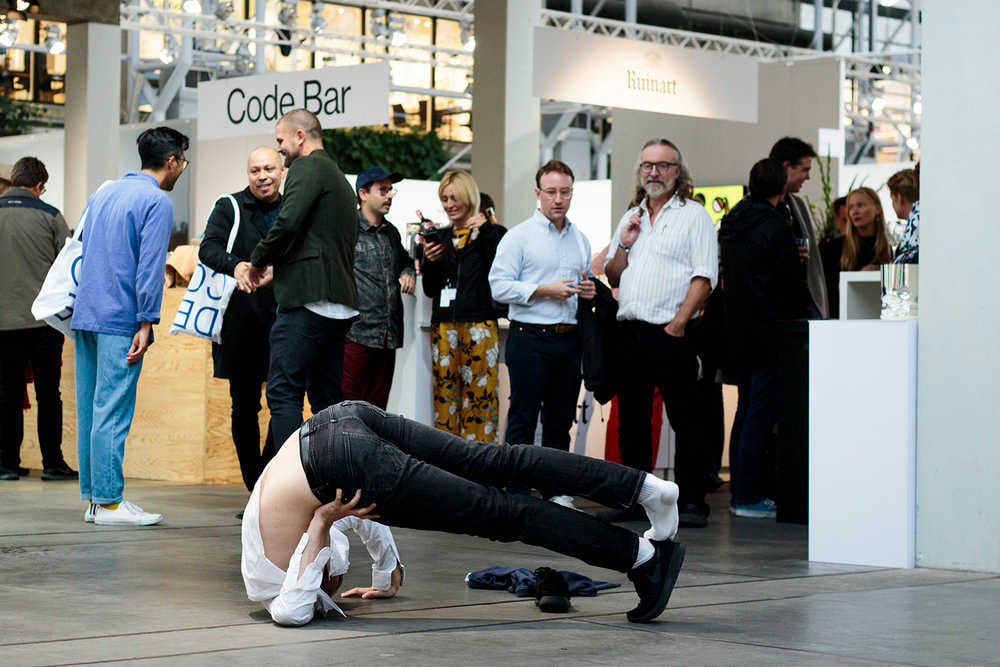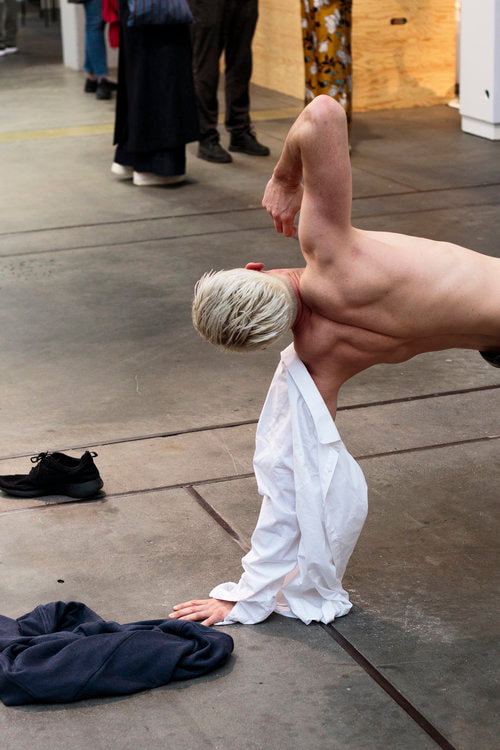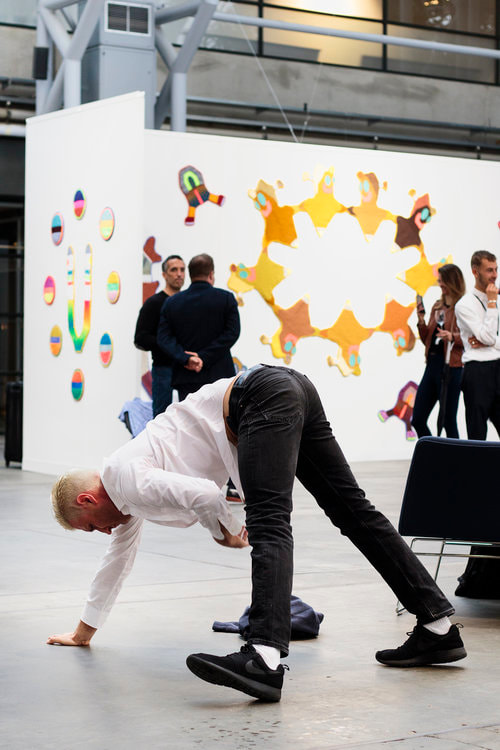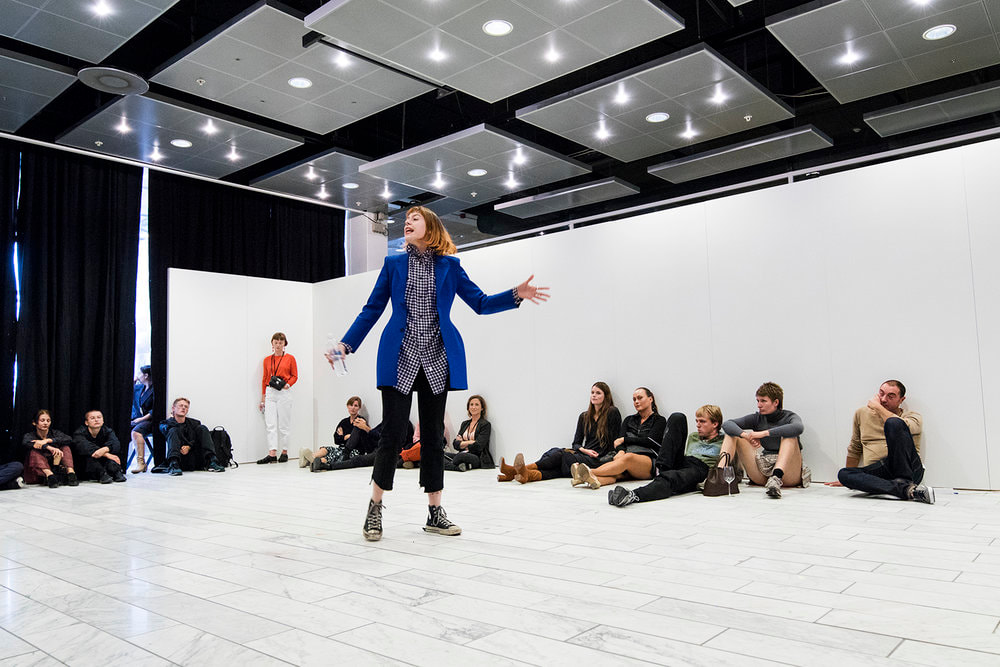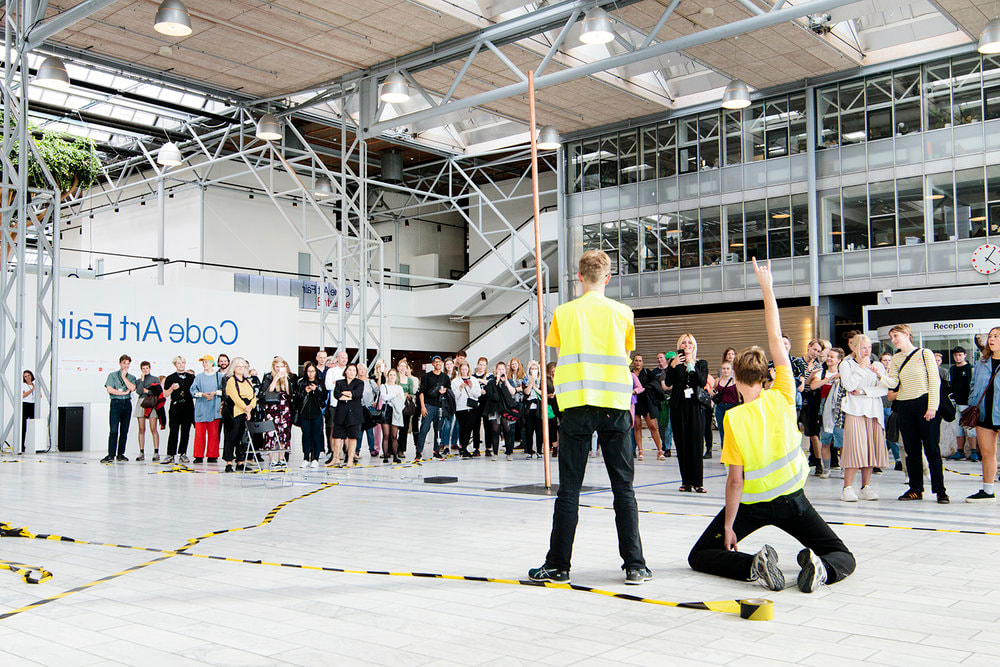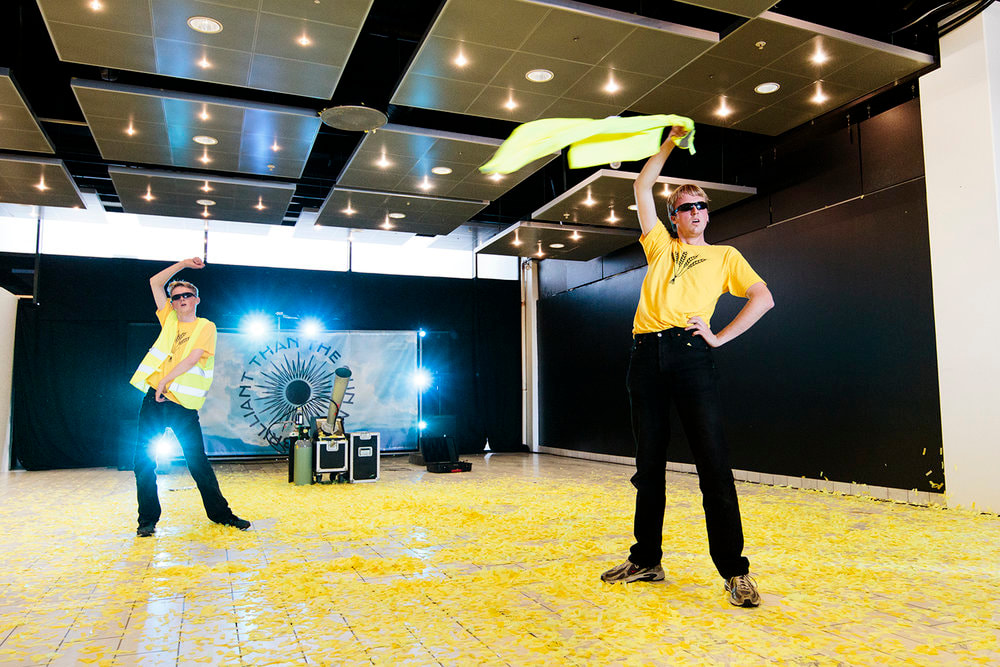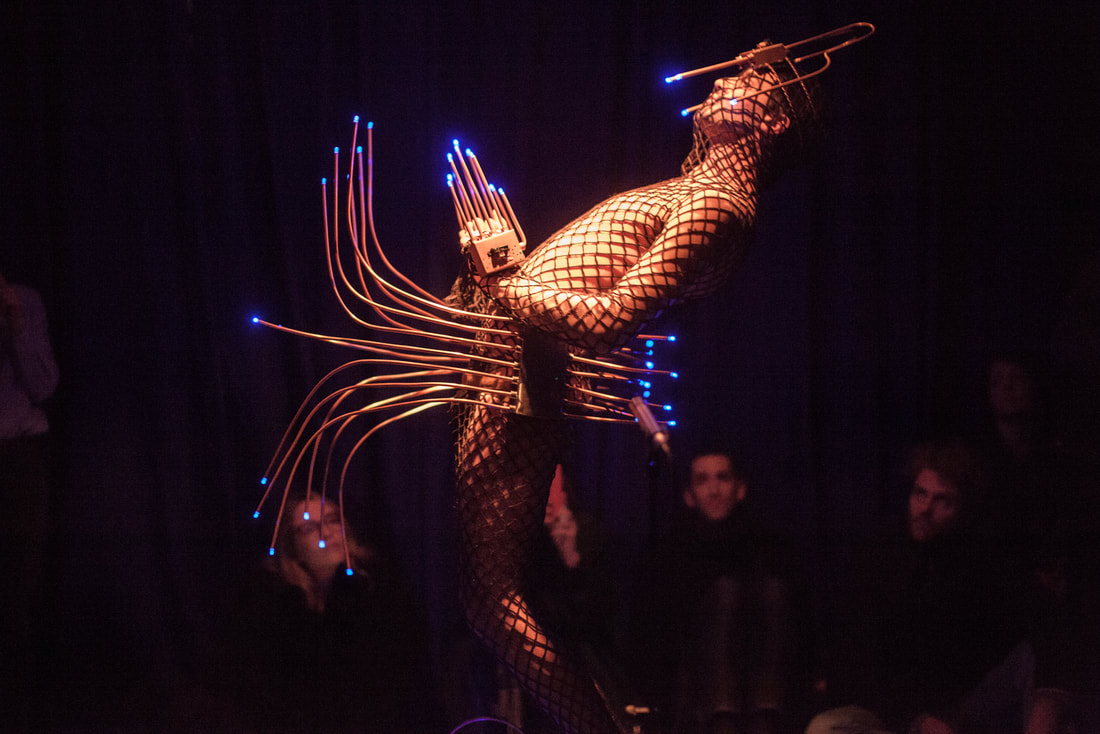2018
Code Art Fair August 30th- September 2nd, 2018
Performance and Talks Program Performing Identities
curated by Irene Campolmi, Code Art Fair CODE 3
With performances by Nora Turato, Jacopo Miliani, Astrit Ismaili & Esben Weile Kjær.
"If the fair itself was to be sure and fairly predictable, talks and performances should be highlighted as a place where the Code stands out. Indeed, the Bella Center's gigantic, cold marble foyers do not give much atmosphere to either profound debates or bodily performative outbreaks, but under the title Performing Identities, a small series of seasons around thematic issues - gender-political, commercial and bodily - unfolds rarely to the commercial fairs."
Louise Steiwer
Journalist & Art Critic, Kunstkritikk
"Med livrem og seler" (With Belt & Braces), 3rd September 2019
CONCEPT
Performing Identities is the 2018 performance and talks program curated by curator and researcher Irene Campolmi for Code Art Fair. The series of performances and talks investigate the body as a site for constructing and negotiating identities within a globalised socio-political context.
The program is grounded in de-colonial and gender emancipatory thought and reflects on how new subjectivities are defined in different ways: from the contemporary extension of the body into the digital, to the creation of modern languages, modes of communications and everyday gestures. The body is seen as an archive, a territory with its cartography and its colonised zones. At the intersection of critical geography, queer and gender studies, the performances presented to create a poetic yet political space within which the body is defined as a microcosm and where forms of resistance and revolution are crafted.
Code Art Fair August 30th- September 2nd, 2018
Performance and Talks Program Performing Identities
curated by Irene Campolmi, Code Art Fair CODE 3
With performances by Nora Turato, Jacopo Miliani, Astrit Ismaili & Esben Weile Kjær.
"If the fair itself was to be sure and fairly predictable, talks and performances should be highlighted as a place where the Code stands out. Indeed, the Bella Center's gigantic, cold marble foyers do not give much atmosphere to either profound debates or bodily performative outbreaks, but under the title Performing Identities, a small series of seasons around thematic issues - gender-political, commercial and bodily - unfolds rarely to the commercial fairs."
Louise Steiwer
Journalist & Art Critic, Kunstkritikk
"Med livrem og seler" (With Belt & Braces), 3rd September 2019
CONCEPT
Performing Identities is the 2018 performance and talks program curated by curator and researcher Irene Campolmi for Code Art Fair. The series of performances and talks investigate the body as a site for constructing and negotiating identities within a globalised socio-political context.
The program is grounded in de-colonial and gender emancipatory thought and reflects on how new subjectivities are defined in different ways: from the contemporary extension of the body into the digital, to the creation of modern languages, modes of communications and everyday gestures. The body is seen as an archive, a territory with its cartography and its colonised zones. At the intersection of critical geography, queer and gender studies, the performances presented to create a poetic yet political space within which the body is defined as a microcosm and where forms of resistance and revolution are crafted.
Jacopo Miliani, Boy oh boy nobody! 2018
Performer: Jacopo Jenna; Photo by IDOART.
Body oh boy nobody! Is a performance that stretches in time and space the act of dressing and undressing as a metaphorical gesture that addresses the many personalities and identities we choose to put on and take off every day. The repetition of this gesture emphasises the variations related to it and makes this everyday action appearing abstract. The performance creates a direct relationship with the audience and demands their active participation in assigning new significances to movements and gestures
Performer: Jacopo Jenna; Photo by IDOART.
Body oh boy nobody! Is a performance that stretches in time and space the act of dressing and undressing as a metaphorical gesture that addresses the many personalities and identities we choose to put on and take off every day. The repetition of this gesture emphasises the variations related to it and makes this everyday action appearing abstract. The performance creates a direct relationship with the audience and demands their active participation in assigning new significances to movements and gestures
Nora Turato, I am happy to own my implicit biases
Nora Turato’s performances are scripted pieces developed through the artist’s omnivorous reading habits through which she browses various cultural outlets from literature to Instagram comments and marketing jingles. While formally her pieces are reminiscent of the late David Antin’s “talk pieces,” yet they are not improvised and have a very different pace and delivery. Her work captures the spirit of the contemporary cultural and social condition. It is a collage of the personalities and identities that we inhabit daily, both online and offline. Turato’s scripts are dense of various kinds of information. They are decontextualised from a temporal moment, but still straightforward and truthful towards the schizophrenia of our time. Her research into performance constructs a verbal image, which results in a sort of literary collage. Turato’s delivery is rapid, and one can easily miss more than one sentence throughout the monologue. Though, she performs the scripts the way she writes them: as a stream of consciousness. Turato’s background in graphic design and its recuperation of language in the service of marketing lets her swiftly move from high-theory to romcom. It is hard to escape irony when cognitive capitalism equally treats Zen aphorisms and the Kardashians to sell yoghurt, yet no point to insist on language's naïve sincerity that makes consumers buy it.
Photo by IDOART.
Nora Turato’s performances are scripted pieces developed through the artist’s omnivorous reading habits through which she browses various cultural outlets from literature to Instagram comments and marketing jingles. While formally her pieces are reminiscent of the late David Antin’s “talk pieces,” yet they are not improvised and have a very different pace and delivery. Her work captures the spirit of the contemporary cultural and social condition. It is a collage of the personalities and identities that we inhabit daily, both online and offline. Turato’s scripts are dense of various kinds of information. They are decontextualised from a temporal moment, but still straightforward and truthful towards the schizophrenia of our time. Her research into performance constructs a verbal image, which results in a sort of literary collage. Turato’s delivery is rapid, and one can easily miss more than one sentence throughout the monologue. Though, she performs the scripts the way she writes them: as a stream of consciousness. Turato’s background in graphic design and its recuperation of language in the service of marketing lets her swiftly move from high-theory to romcom. It is hard to escape irony when cognitive capitalism equally treats Zen aphorisms and the Kardashians to sell yoghurt, yet no point to insist on language's naïve sincerity that makes consumers buy it.
Photo by IDOART.
Esben Weile Kjær, More Brilliant Than the Sun
MORE BRILLIANT THAN THE SUN is a performance by Esben Weile Kjær celebrating popular cultural events ( example), critically de-contextualising these from terms and expressions of their original context. The title draws from Eshun’s homonymous book “More Brilliant than the Sun: Adventures in Sonic Fiction”, a militant exploration on posthuman scenarios seen through science fiction. Inspired by the vital and revolutionary energy of the book, Weile Kjær reflects on the highest euphoric high-voltage moment in which a community realises that their actions have exceeded the conventionally allowed limits. By mixing sound, choreography, clothes, a frivolous scene and copious amounts of confetti, the performance creates a mixture aesthetics, which is reminiscent of that experienced in stadiums, concerts, festivals or city celebrations. The piece strives to create a mood of a party among the audience that could explode at any time. Once the performance ends, people are left with a sense of abandonment that is perceived when an intense experience is undergone. Photo by IDOART.
MORE BRILLIANT THAN THE SUN is a performance by Esben Weile Kjær celebrating popular cultural events ( example), critically de-contextualising these from terms and expressions of their original context. The title draws from Eshun’s homonymous book “More Brilliant than the Sun: Adventures in Sonic Fiction”, a militant exploration on posthuman scenarios seen through science fiction. Inspired by the vital and revolutionary energy of the book, Weile Kjær reflects on the highest euphoric high-voltage moment in which a community realises that their actions have exceeded the conventionally allowed limits. By mixing sound, choreography, clothes, a frivolous scene and copious amounts of confetti, the performance creates a mixture aesthetics, which is reminiscent of that experienced in stadiums, concerts, festivals or city celebrations. The piece strives to create a mood of a party among the audience that could explode at any time. Once the performance ends, people are left with a sense of abandonment that is perceived when an intense experience is undergone. Photo by IDOART.
Astrit Ismaili, The New Body
Central to Ismaili’s interest in performance is how identities are constructed and interpreted through contemporary mechanisms, but also how they are heard, asking what it means to 'sonify' a body (i.e. to make it sound something else, for example, a new melody or language) and what kind of political meanings would this imply. During the performance, sonic adjuncts installed onto the artist's body trigger different soundscapes as they move through the gallery. By translating each body's gesture into a sound, the artist aims at disrupting prevailing narratives around representation, imagining new
Central to Ismaili’s interest in performance is how identities are constructed and interpreted through contemporary mechanisms, but also how they are heard, asking what it means to 'sonify' a body (i.e. to make it sound something else, for example, a new melody or language) and what kind of political meanings would this imply. During the performance, sonic adjuncts installed onto the artist's body trigger different soundscapes as they move through the gallery. By translating each body's gesture into a sound, the artist aims at disrupting prevailing narratives around representation, imagining new
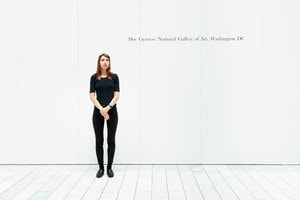
Alfredo Aceto, Doc Gyneco: National Gallery of Art, Washington DC
Aceto presents its first performance conceived as a one-act play that goes intermittently for an hour reciting a text on the rapper Doc Gyneco and his imaginary metamorphosis and change of identity into animal forms.
Photo: IDOART
Aceto presents its first performance conceived as a one-act play that goes intermittently for an hour reciting a text on the rapper Doc Gyneco and his imaginary metamorphosis and change of identity into animal forms.
Photo: IDOART
